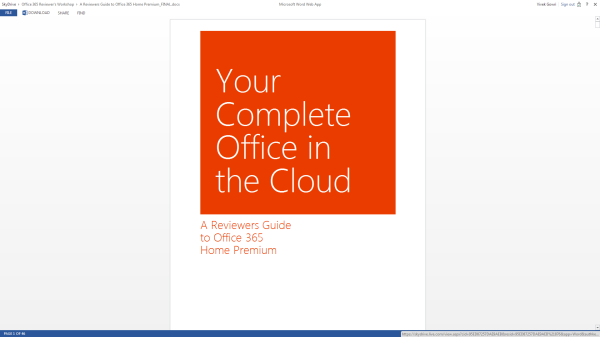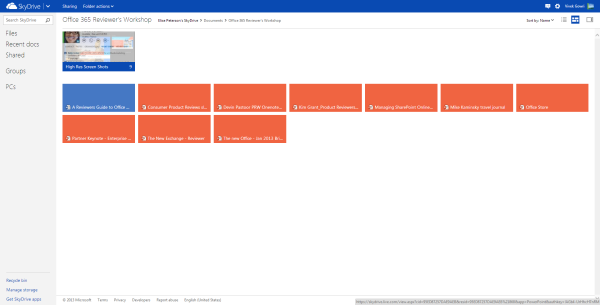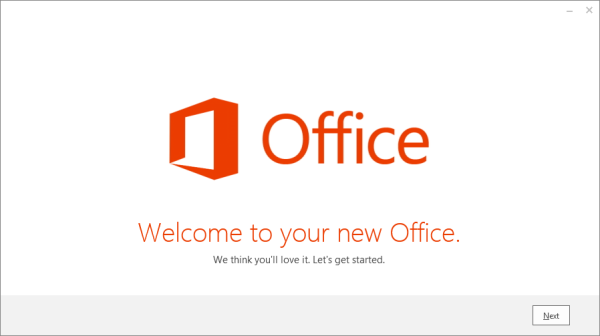Three Months with Microsoft's Office 365
by Vivek Gowri on January 31, 2013 11:59 PM EST- Posted in
- Microsoft
- Cloud Computing
- Office 2013
- SkyDrive
How big is Microsoft pushing the cloud integration in Office 2013? After signing into a Microsoft account, SkyDrive is the default save location in all Office apps, replacing the local My Documents folder. That’s an important distinction, because SkyDrive is a huge part of the Office 365 message (and likewise, Office integration is a huge part of SkyDrive’s appeal).
Combined with Office Web Apps in SkyDrive, the Office+SkyDrive combination is actually a pretty powerful way of creating and editing documents and presentations from the web, much more so than Google Docs is. And in that, I think Office 365 makes some huge strides in matching the convenience factor of Google’s purely online document creation tools, except with all the versatility and formatting power that comes with proper Office.
Sharing files from SkyDrive is also a breeze, much like Dropbox. And honestly, between the cheaper storage upgrades and Office integration, SkyDrive looks like a pretty compelling option for cloud storage when compared to Dropbox. Microsoft is doing a good job of leveraging its own products and services for better online integration, and that’s really one of the main stories in the new Office.
I’m coming away from Office 365 a big fan of the Office 2013 suite, along with a newfound appreciation of SkyDrive. The combination is a potent one, and could make the lives of students and professionals much, much easier. Unlike many Microsoft software redesigns of years past, including Windows 8, I don’t have too much in the way of misgivings about this one. The improvements are pretty comprehensive, and offer a more streamlined, polished, and visually refined user experience. That’s about all you can ask from an office suite.
My real questions center primarily around the subscription model. And even that is mostly limited to single or dual user families that don’t have access to a University subscription or Microsoft’s historically lenient home use agreements for commercial licenses. The $99 yearly price for Office 365 is pretty steep if you don’t make use of either the multi-computer install capabilities or the cloud services. I’d say in that case, you’re probably better off just getting a standalone Office 2013 license and signing up for a SkyDrive account which comes with 7GB of free storage. If you really need more storage, the 20GB upgrade only costs $10 per year, which isn’t bad at all. Or, alternatively, you could pay a student to get you an Office 365 University serial number on the cheap. [Update: I was joking about this part, sorry if it didn't come across that way. Yes, it violates the EULA, so no, don't do this.]
Other than that? It’s great. If you’ve got 4 or 5 computers to install Office on, $99/year isn’t bad at all, and for students that can get the University license, $79 for 4 years is a bargain considering that it comes with 20GB of SkyDrive storage for that four year stretch of time. If you have Office 2010 and are happy with it, I wouldn’t say you need to upgrade though the cloud integration makes that a compelling option, but for users of any previous edition Office, I’d seriously recommend making the transition.













113 Comments
View All Comments
Wolfpup - Thursday, March 7, 2013 - link
Right. Just because somethings the "in" thing to do doesn't mean it makes sense. We have shadows and the like FOR A REASON. It wasn't random, it's to give visual indication of what's clickable, what's on top of what, etc. Taking that away in the service of this year's "style" is inane.guidryp - Friday, February 1, 2013 - link
Color isn't needless crap.Monochrome icons make things harder to discover. I find that I have to look at them longer to identify them. We are only talking seconds, but it is evident that they are less ergonomic.
The flat monochromatic looks is like the early 1990's all over again.
We suffered through that once, no need to do it again.
Microsoft current UI changes suck.
It is bad enough they are forcing Metro on us, but they are also trying to make all their traditional UI's look flat a featureless as well.
name99 - Friday, February 1, 2013 - link
Wow! It's obvious designers have learned NOTHING from the 20th century.100 years after Mies van der Rohe, fifty years after Jane Jacobs and Cabrini-Green and we still have this bizarre "Fsck you, public. We are the designers, we know style, you stupid ignorant opinions mean nothing to us." attitude.
Did people prefer cutting out the "needless crap" of modernist architecture? Was the "machine for living" REALLY more efficient? Yes, Villa Tugendhat, to take one example, looks nice in a photo. But is it ACTUALLY a house you want to live in? Especially taking into account the massive cost to build it, then the massive cost to maintain it (turns out flat roofs leak horribly in a wet climate --- who would have though? turns out glass, especially 1930s glass, doesn't hold heat well in a cold climate --- who'd have thought?).
Have you NO humility man? Are you not the slightest interested in the possibility that perhaps usability matters to people more than pure aesthetics? Are you completely unaware of the historical parallels to your current unbridled arrogance?
steven75 - Sunday, February 3, 2013 - link
You can seriously look at that Outlook screenshot and tell me with a straight face its not a complete chaotic mess?steven75 - Sunday, February 3, 2013 - link
And comparing a website to something like Outlook makes it clear you have no idea what the difference is between a tool (Outlook) and content you passively read like a website.ThePegasi - Thursday, February 7, 2013 - link
How you managed to navigate to this article, let alone type and post a response, is somewhat baffling if all you do is read websites rather than interact with them. Many websites are just as much a tool as Outlook. You use navigation buttons, and even menus, and also read content (whether it be web content or an email). App-style interaction is very common on newer websites (which are the ones we're talking about if the discussion is around the most recent approaches to web design).Tams80 - Friday, February 8, 2013 - link
This website isn't too bad. The Verge on the other hand, that would be a better analogy; i.e. bleurgh!!! (to the people you seem to be trying to preach to).There was no need for Microsoft to not have an option for us to use the older UI, it wouldn't have changed functionality. With what's happened with W8 though, that was never going to happen.
ThePegasi - Thursday, February 7, 2013 - link
Just to be clear, I don't necessarily agree with all the assertions he/she made, but I felt that this particular distinction you made was worth addressing.cyberguyz - Monday, February 4, 2013 - link
Looks like MS Office (and by extension Win 8) was designed by people just like you friend - designers that Just Don't Get It. The whole freaking lot of you should be fired and replaced by 5-year-olds armed with crayons. They couldn't do any worse.I have Office 2013 co-installed with Office 2010 (the 2013 was a freebie upgrade for me) on one of my systems. Y'know what? Outlook 2013 looks so bad that I will just not use it. Guess which MS Office I do use on a regular basis.
Office and Windows may be just dandy feature-wise, but if Microsoft insists on following this butt-ugly UI course there are on, they have seen the last dime of profit they will be making from me. I am voting with my wallet just as all other paying consumers are voting with theirs. Judging from Microsoft's profit reports, I have a pretty good idea how that vote is going.
Murloc - Friday, February 1, 2013 - link
I have to agree with B3an, it's us people becoming older and being nostalgic of old-fashioned stuff.All the design is going in this direction althoguh I like windows 7 aero style more, but I understand that it's old fashioned and I'm behaving like an old woman who keeps wearing clothes that were fashionable in the 50s because it's just what she's used to.
We have to get over it. Colorful icons look too busy and cheap for todays' standards.
In a few years when someone sees a shiny design similar to windows 7, he will say:
"hey the 00s called....".